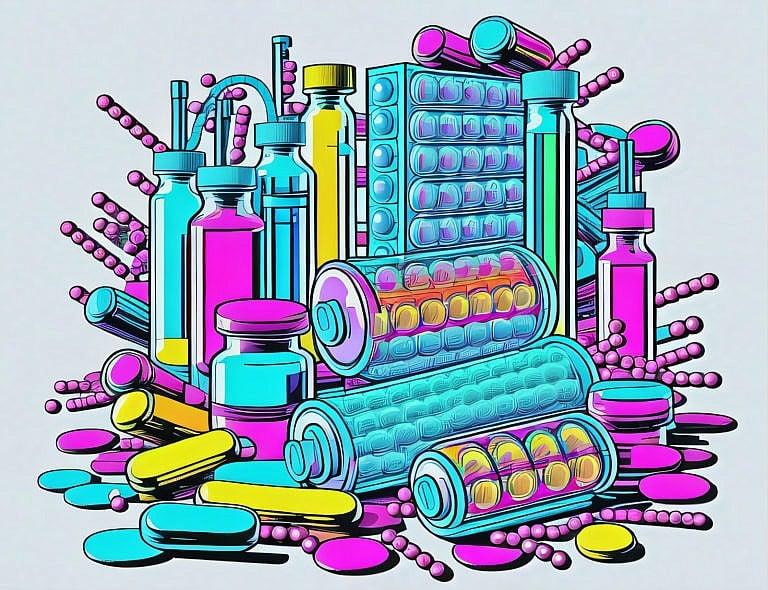We’ll develop new drugs in months, not decades
Our research team used machine learning to discover a new antibiotic. And that’s just the beginning.

(This illustration was created by Maclean’s art director Anna Minzhulina using the generative AI image program Imagine. Minzhulina spent weeks feeding prompts into the program, inspired by the essay.)
Share
Jonathan Stokes is an assistant professor of biochemistry and biomedical sciences at McMaster University.

Humanity has relied on antibiotics for the better part of 100 years. Most of the ones we currently use in clinical and agricultural settings were discovered between the 1940s and 1960s by looking for antibacterial molecules produced by microbes living in soil. Eventually, this method led to the discovery of the same antibiotics over and over again, and our rich well seemingly dried. More recently, researchers assembled libraries of millions of synthetic chemicals and individually tested which ones kill pathogenic bacteria. This process—called high-throughput screening—is time-consuming and expensive. Unfortunately, we’ve discovered zero clinically used antibiotics with this approach. Our antibiotic pipeline is now alarmingly lean.
In 2019, there were approximately 1.3 million deaths due to drug-resistant bacterial infections. By 2050, that number is expected to increase to 10 million per year, at which point it will surpass cancer as a cause of death. Antibiotics uphold all of modern medicine. If we can’t control infection, we can’t perform a lot of the medical interventions that we take for granted, such as routine surgeries and cancer chemotherapy.
Artificial intelligence is finding its way into every part of modern drug development, from early molecule discovery to clinical trials. At the first stage, AI models can help us predict and design new chemicals to address therapeutic challenges much more efficiently than testing chemicals in the lab. For example, in the lab we can explore, at the upper limit, a couple million molecules to see which ones are active against bacteria. In the computer, we can easily explore billions.
For AI to help us discover new antibiotics, we need to train models to understand what these drugs look like. This is the process in a nutshell: first, we test roughly 10,000 different molecules in the laboratory to see which are antibacterial and which are not. Then, in the computer, we can train the AI model to recognize the chemical structures of molecules that are antibacterial and the ones that are not. Once we have the model trained, we can show it brand new chemicals it has never seen before and it can tell us which molecules might have antibacterial potential. We can use an AI model to run predictions on 100 million chemicals in about a week. In the lab, screening that many chemicals would take us more than 20 years.
One pathogen that urgently needs new antibiotics is Acinetobacter baumannii, which lives in hospitals. This pathogen takes up DNA from its environment. In a hospital, there is an abundance of DNA encoding antibiotic resistance genes; thus, many A. baumannii isolates are resistant to many, if not all, current antibiotics. This bacterium is highly virulent and causes many different infections, like meningitis and pneumonia. Estimated mortality is one in four.
Our team wanted to find a new antibiotic to treat it. To start, we went into the lab and screened 7,500 chemicals to see which ones could inhibit the growth of A. baumannii in a dish. This was a few weeks of work. Then, using that data, we trained an AI model to predict new molecules that might act against A. baumannii. Our AI model pulled out a chemical that we named abaucin. When we tested abaucin in the lab, it inhibited the growth of A. baumannii in a dish, just like the model predicted.
This is a good start, but there are a whole list of other important properties that a molecule must have to become a new clinical medicine. It’s not enough for antibiotics to kill bacteria. They also need to be soluble in human tissues, get to the site of the infection and stay there long enough to do their job, and be well-tolerated by humans. Many molecules can kill bacteria in a dish, but many will also kill people. We’re training new AI models to predict multiple properties simultaneously, so we can rapidly determine which chemicals are worth our effort to test in the lab and which are likely to make good drugs for clinical use.
If we are able to acquire sufficient quantities of data with which to train AI models, there’s no limit to what these algorithms can help us do. We’re already looking for new antibiotic drugs, antifungal drugs and brain cancer medicines. In the world I envision, drug discovery can become rapid and inexpensive, because of AI models that can guide us through this complex process much more efficiently. Right now, it takes more than $2 billion and 10 to 15 years of investment to get a new medicine from idea to market. Using state-of-the-art AI models, we’re working toward cutting both of those numbers in half. It’s an aggressive but attainable target. Once we reach that goal, then the question is, can we reach less than a billion dollars and two or three years? What about developing new drugs in a few months? I think we can do it.
The appropriate use of AI for drug discovery means people will get new, more effective medicines more rapidly and for less expense. It means we will see a global increase in human quality of life. That’s a good outcome.
We reached out to Canada’s top AI thinkers in fields like ethics, health and computer science and asked them to predict where AI will take us in the coming years, for better or worse. The results may sound like science fiction—but they’re coming at you sooner than you think. To stay ahead of it all, read the other essays that make up our AI cover story, which was published in the November 2023 issue of Maclean’s. Subscribe now.